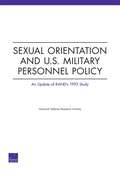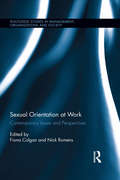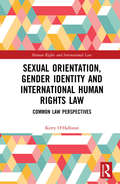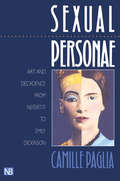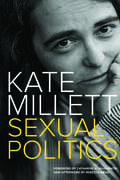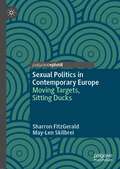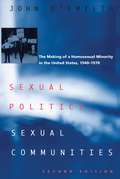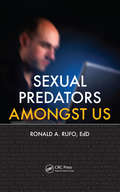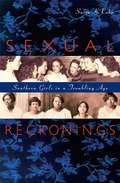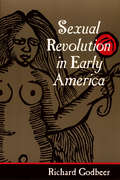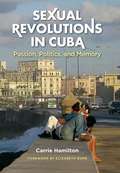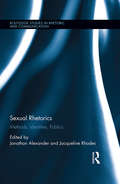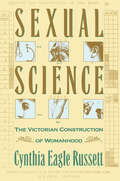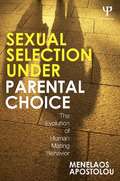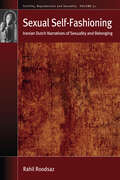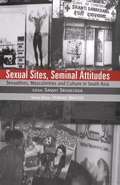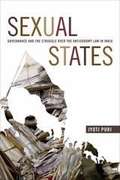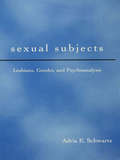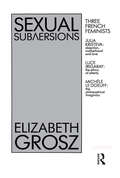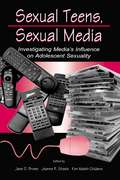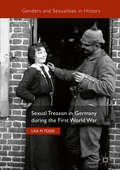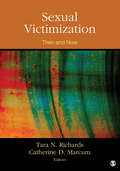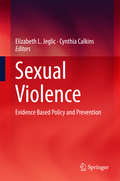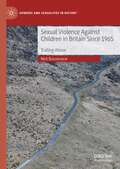- Table View
- List View
Sexual Orientation and U.S. Military Personnel Policy: An Update of RAND's 1993 Study
by National Defense Research InstituteThis study on sexual orientation and U.S. military policy, requested by the Senate Armed Services Committee and the Secretary of Defense in order to weigh repeal of the "Don't Ask, Don't Tell" policy, examines public and military opinion on allowing gay men and lesbians to serve without restriction; research on sexual orientation, unit cohesion, and recruiting and retention; and experiences of domestic agencies and foreign militaries.<P> From the Inside Flap:<P> Summary • Overview • The History of "Don't Ask, Don't Tell" • Context: Broad Social Changes and Public Opinion • Sexual Orientation and Disclosure • Unit Cohesion and Military Performance • Potential Effects on Military Recruiting and Retention • Health Implications • Focus Groups of Military Personnel • RAND Survey of Gay, Lesbian, and Bisexual Military Personnel • The Experience of Foreign Militaries • The Experience of Domestic Agencies: Police, Fire, and Federal Agencies • The Experience of Other Domestic Organizations: Corporations and Universities • Implementation • Appendix
Sexual Orientation at Work: Contemporary Issues and Perspectives (Routledge Studies in Management, Organizations and Society)
by Nick Rumens Fiona ColganSexual Orientation at Work: Contemporary Issues and Perspectives brings together contemporary international research on sexual orientation and draws out its implications for lesbian, gay, bisexual, trans and heterosexual employees and managers. It provides new empirical and theoretical insights into sexual orientation employment discrimination and equality work in countries such as South Africa, Turkey, Australia, Austria, Canada, US and the UK. This book is novel in its focus on how sexual orientation intersects with other aspects of difference such as age, class, ethnicity and disability. It adopts new theoretical perspectives (e.g. queer theory) to analyze the rise of new ‘gay-friendly’ organizations, and examines important methodological issues in collecting socio-economic data about sexual minorities. Providing an accessible account of key issues and perspectives on sexual orientation in the workplace, Sexual Orientation at Work caters to a wide range of readers across business, feminist, and LGBT/Queer Studies fields.
Sexual Orientation, Gender Identity and International Human Rights Law: Common Law Perspectives (Human Rights and International Law)
by Kerry O'HalloranThis book identifies, analyses and discusses the nexus of legal issues that have emerged in recent years around sexuality and gender. It audits these against specific human rights requirements and evaluates the outcomes as evidenced in the legislation and caselaw of six leading common law jurisdictions. Beginning with a snapshot of the legal definitions and sanctions associated with the traditional marital family unit, the book examines the subsequently evolving key concepts and constructs before outlining the contemporary international framework of human rights as it relates to matters of sexuality and gender. It proceeds by identifying a set of themes, including the rights to identity, to form a family, to privacy, to equality and to non-discrimination, and undertakes a comparative evaluation of how these and other themes indicate areas of commonality and difference in the approaches adopted in those common law jurisdictions, as illustrated by the associated legislation and caselaw. It then considers why this should be and assesses the implications.
Sexual Personae
by Camille PagliaIn this brilliantly original book, Camille Paglia identifies some of the major patterns that have endured in western culture from ancient Egypt and Greece to the present. According to Paglia, one source of continuity is paganism, which, undefeated by Judeo-Christianity, continues to flourish in art, eroticism, astrology, and pop culture. Others, she says, are androgyny, sadism, and the aggressive western eye, which has created our art and cinema. Paglia follows these and other themes from Nefertiti and the Venus of Willendorf to Apollo and Dionysus, from Botticelli and Michaelangelo to Shakespeare and Blake and finally to Emily Dickinson, who, along with other major nineteenth-century authors, becomes a remarkable example of Romanticism turned into Decadence. Paglia offers provocative views of literature, art history, psychology, and religion. She focuses, for example, on the amorality, voyeurism, and pornography in great art that have been ignored or glossed over by most critics. She discusses sex and nature as brutal daemonic forces, and she criticizes feminists for sentimentality or wishful thinking about the causes of rape, violence, and poor relations between the sexes. She stressed the biologic basis of sex differences and sees the mother as an overwhelming force who condemns men to lifelong sexual anxiety, from which they escape through rationalism and physical achievement. She examines the culture and style of modern male homosexuals. She demonstrates how much of western life, art, and thought is ruled by personality, which she traces through recurrent types or personae such as the female vampire (Medusa, Lauren Bacall); the pythoness (the Dephic oracle, Gracie Allen); the beautiful boy (Hadrian's Antinous, Dorian Gray); the epicene man of beauty (Lord Byron, Elvis Presley); and the male heroine (Baudelaire, Woody Allen). Her book will stimulate and awe readers everywhere.
Sexual Politics
by Kate MillettA sensation upon its publication in 1970, Sexual Politics documents the subjugation of women in great literature and art. Kate Millett's analysis targets four revered authors—D. H. Lawrence, Henry Miller, Norman Mailer, and Jean Genet—and builds a damning profile of literature's patriarchal myths and their extension into psychology, philosophy, and politics. Her eloquence and popular examples taught a generation to recognize inequities masquerading as nature and proved the value of feminist critique in all facets of life. This new edition features the scholar Catharine A. MacKinnon and the New Yorker correspondent Rebecca Mead on the importance of Millett's work to challenging the complacency that sidelines feminism.
Sexual Politics in Contemporary Europe: Moving Targets, Sitting Ducks
by May-Len Skilbrei Sharron FitzGeraldThe legal regulation of gender and sexuality has undergone dramatic changes throughout Europe in the last 40 years and this has shaped what it means to be a European citizen. Drawing on a range of interdisciplinary research, this book uses the discourses around current European sexual politics as an entry point to interrogate how, and with what effect, the EU and its Member States harness issues of gender and sexuality to support issues of higher political importance. It takes recent and ongoing political debates and legislative changes around prostitution and sexual assault as a focus. Using four national case studies: Poland, Germany, Sweden and Italy it illuminates how the EU’s desire for increased harmonisation across the Union around gender and sexuality norms and values operates differently and with specific effects across Member States. The book’s structure provides a detailed map of how and why contemporary European sexual politics is changing, and how this contributes to establishing European norms and values in developments in law and policy around prostitution and sexual assault. By examining how and why the EU and its Member States implement their policies in these two policy areas we can begin to illuminate how contemporary European sexual politics serve some groups’ interests while marginalizing ‘Others’.
Sexual Politics in Modern Iran
by Janet AfaryJanet Afary is a native of Iran and a leading historian. Her work focuses on gender and sexuality and draws on her experience of growing up in Iran and her involvement with Iranian women of different ages and social strata. These observations, and a wealth of historical documents, form the kernel of this book, which charts the history of the nation's sexual revolution from the nineteenth century to today. What comes across is the extraordinary resilience of the Iranian people, who have drawn on a rich social and cultural heritage to defy the repression and hardship of the Islamist state and its predecessors. It is this resilience, the author concludes, which forms the basis of a sexual revolution taking place in Iran today, one that is promoting reforms in marriage and family laws, and demanding more egalitarian gender and sexual relations.
Sexual Politics, Sexual Communities: The Making of a Homosexual Minority in the United States, 1940–1970
by John D'EmilioWith thorough documentation of the oppression of homosexuals and biographical sketches of the lesbian and gay heroes who helped the contemporary gay culture to emerge, Sexual Politics, Sexual Communities supplies the definitive analysis of the homophile movement in the U.S. from 1940 to 1970. John D'Emilio's new preface and afterword examine the conditions that shaped the book and the growth of gay and lesbian historical literature. "How many students of American political culture know that during the McCarthy era more people lost their jobs for being alleged homosexuals than for being Communists? . . . These facts are part of the heretofore obscure history of homosexuality in America—a history that John D'Emilio thoroughly documents in this important book."—George DeStefano, Nation "John D'Emilio provides homosexual political struggles with something that every movement requires—a sympathetic history rendered in a dispassionate voice."—New York Times Book Review "A milestone in the history of the American gay movement."—Rudy Kikel, Boston Globe
Sexual Predators Amongst Us
by Ronald A. RufoIt is imperative that educators, parents, and potential victims be aware of sexual predators, the danger they pose in our society, and the resources available to help prevent this growing epidemic. Written from a police perspective, Sexual Predators Amongst Us examines the problem of sexual predation, how the Internet has contributed to its growth,
Sexual Reckonings: Southern Girls in a Troubling Age
by Susan CahnSexual Reckonings is the fascinating tale of adolescent girls coming of age in the South during the most explosive decades for the region. Focusing on the period from 1920 to 1960, Susan Cahn reveals how both the life of the South and the meaning of adolescence underwent enormous political, economic, and social shifts. Those years witnessed the birth of a modern awareness of adolescence and female sexuality that clashed mightily with the white supremacist and patriarchal legacies of the old South. As youth staked its claim, the bodies and beliefs of southern girls became the battlefield for a transformed South, which was, like them, experiencing growing pains. Cahn reveals how young women, both white and black, were seen as the South's greatest hope and its greatest threat. Viewed as critical actors in every regional crisis, from the economic recession and urban migrations of the 1920s to the racial conflicts precipitated by school desegregation in the 1950s, female teenagers became the conspicuous subjects of social policy and regional imagination. All the while, these adolescents pursued their own desires and discovered their own meanings, creating cracks in the twin pillars of the Jim Crow South--"racial purity" and white male dominance--that would soon be toppled by the student-led civil rights movement. Sexual Reckonings is an amazingly intimate look at a time of deep personal exploration and profound cultural change for southern girls and for the society they inhabited, a powerful account of the clash between a society's fears and the daily lives and aspirations of its most prized, and unpredictable, population.
Sexual Revolution in Early America (Gender Relations in the American Experience)
by Richard GodbeerAn Alternate Selection of the History Book ClubIn 1695, John Miller, a clergyman traveling through New York, found it appalling that so many couples lived together without ever being married and that no one viewed "ante-nuptial fornication" as anything scandalous or sinful. Charles Woodmason, an Anglican minister in South Carolina in 1766, described the region as a "stage of debauchery" in which polygamy was "very common," "concubinage general," and "bastardy no disrepute." These depictions of colonial North America's sexual culture sharply contradict the stereotype of Puritanical abstinence that persists in the popular imagination.In Sexual Revolution in Early America, Richard Godbeer boldly overturns conventional wisdom about the sexual values and customs of colonial Americans. His eye-opening historical account spans two centuries and most of British North America, from New England to the Caribbean, exploring the social, political, and legal dynamics that shaped a diverse sexual culture. Drawing on exhaustive research into diaries, letters, and other private papers, as well as legal records and official documents, Godbeer's absorbing narrative uncovers a persistent struggle between the moral authorities and the widespread expression of popular customs and individual urges.Godbeer begins with a discussion of the complex attitude that the Puritans had toward sexuality. For example, although believing that sex could be morally corrupting, they also considered it to be such an essential element of a healthy marriage that they excommunicated those who denied "conjugal fellowship" to their spouses. He next examines the ways in which race and class affected the debate about sexual mores, from anxieties about Anglo-Indian sexual relations to the sense of sexual entitlement that planters held over their African slaves. He concludes by detailing the fundamental shift in sexual culture during the eighteenth century towards the acceptance of a more individualistic concept of sexual desire and fulfillment. Today's moral critics, in their attempts to convince Americans of the social and spiritual consequences of unregulated sexual behavior, often harken back to a more innocent age; as this groundbreaking work makes clear, America's sexual culture has always been rich, vibrant, and contentious.
Sexual Revolutions in Cuba
by Carrie HamiltonIn Sexual Revolutions in Cuba Carrie Hamilton delves into the relationship between passion and politics in revolutionary Cuba to present a comprehensive history of sexuality on the island from the triumph of the Revolution in 1959 into the twenty-first century. Drawing on an unused body of oral history interviews as well as press accounts, literary works, and other published sources, Hamilton pushes beyond official government rhetoric and explores how the wider changes initiated by the Revolution have affected the sexual lives of Cuban citizens. She foregrounds the memories and emotions of ordinary Cubans and compares these experiences with changing policies and wider social, political, and economic developments to reveal the complex dynamic between sexual desire and repression in revolutionary Cuba. Showing how revolutionary and prerevolutionary values coexist in a potent and sometimes contradictory mix, Hamilton addresses changing patterns in heterosexual relations, competing views of masculinity and femininity, same-sex relationships and homophobia, AIDS, sexual violence, interracial relationships, and sexual tourism. Hamilton's examination of sexual experiences across generations and social groups demonstrates that sexual politics have been integral to the construction of a new revolutionary Cuban society.
Sexual Rhetorics: Methods, Identities, Publics (Routledge Studies in Rhetoric and Communication)
by Jonathan Alexander Jacqueline RhodesSexual rhetoric is the self-conscious and critical engagement with discourses of sexuality that exposes both their naturalization and their queering, their torquing to create different or counter-discourses, giving voice and agency to multiple and complex sexual experiences. This volume explores the intersection of rhetoric and sexuality through the varieties of methods available in the fields of rhetoric and writing studies, including case studies, theoretical questioning, ethnographies, or close (and distant) readings of "texts" that help us think through the rhetorical force of sexuality and the sexual force of rhetoric.
Sexual Science: The Victorian Construction of Womanhood
by Cynthia Eagle Russett“Able, patient and often witty . . . provides a critically useful case study of a period when the level of distortion reached dramatic new heights.” (New York Times Book Review)One scarcely knows whether to laugh or cry. The spectacle presented, in Cynthia Russett's splendid book, of nineteenth-century white male scientists and thinkers earnestly trying to prove women inferior to men—thereby providing, along with "savages" and "idiots," an evolutionary buffer between men and animals—is by turns appalling, amusing, and saddening. Surveying the work of real scientists as well as the products of more dubious minds, Russett has produced a learned yet immensely enjoyable chapter in the annals of human folly.At the turn of the century science was successfully challenging the social authority of religion; scientists wielded a power no other group commanded. Unfortunately, as Russett demonstrates, in Victorian sexual science, empiricism tangled with prior belief, and scientists' delineation of the mental and physical differences between men and women was directed to show how and why women were inferior to men. No other work has treated this provocative topic so completely, nor have the various scientific theories used to marshal evidence of women's inferiority been so thoroughly delineated and debunked. Erudite enough for scholars in the history of science, intellectual history, and the history of women, this book with its stylish presentation will also attract a larger mainstream audience.Winner of the Berkeley Conference of Women Historians Book Award
Sexual Selection Under Parental Choice: The Evolution of Human Mating Behavior
by Menelaos ApostolouParents often disagree with their children over their choice of partner. Although the reasons may vary the outcome is very often one of conflict – a conflict peculiar to the human species. For the first time in one volume, Sexual Selection under Parental Choice employs an evolutionary perspective to understand this conflict and explore its implications. Covering recent developments in the field of evolutionary psychology, Menelaos Apostolou reveals the extent of parental attempts to control the mating decisions of their offspring and investigates the qualities parents seek in prospective in-laws. Children’s attempt to escape this control can lead to practices such as foot-binding and clitoridectomy or, in postindustrial societies, more subtle forms of coercion and manipulation. Apostolou demonstrates that much of human mating behavior has been shaped by parental choice and that parents have a significant influence in sexual selection: the traits they favour in their children’s mates are selected and increase in frequency in the population. Sexual Selection under Parental Choice will be ideal reading for researchers and advanced students of evolutionary, developmental and social psychology, as well as other related disciplines such as social anthropology, sociology and the biological sciences.
Sexual Self-Fashioning: Iranian Dutch Narratives of Sexuality and Belonging (Fertility, Reproduction and Sexuality: Social and Cultural Perspectives #51)
by Rahil RoodsazSexuality and gender have come to serve as measures for cultural belonging in discussions of the position of Muslim immigrants in multicultural Western societies. While the acceptance of assumed local norms such as sexual liberty and gender equality are seen as successful integration, rejecting them is regarded as a sign of failed citizenship. Focusing on premarital sex, homosexuality, and cohabitation outside marriage, this book provides an ethnographic account of sexuality among the Iranian Dutch. It argues that by embracing, rejecting, and questioning modernity in stories about sexuality, the Iranian Dutch actively engage in processes of self-fashioning.
Sexual Sites, Seminal Attitudes
by Sanjay SrivastavaDiscussions on sexuality in the South Asian context have tended to focus largely on men`s preoccupations through notions such as `semen-anxiety`. Another restrictive framework is the excessive importance ascribed to religion in everyday life. The result has been a rather narrow debate on sexuality. By providing accounts of a myriad sites and meanings of sexuality, this remarkable volume broadens the debate on sexuality in South Asia. It combines perspectives from history, anthropology, and cultural and literary studies to provide an interdisciplinary exploration of the cultures of, and the multiple meanings and contestations that gather around, masculinities and sexualities. The collection is unique in the breadth of its theoretical concerns; its focus on hitherto marginalized sexual identities; and its novel juxtapositions of analyses of colonial discourses with those of postcolonised modernity.
Sexual States: Governance and the Struggle over the Antisodomy Law in India
by Jyoti PuriIn Sexual States Jyoti Puri tracks the efforts to decriminalize homosexuality in India to show how the regulation of sexuality is fundamentally tied to the creation and enduring existence of the state. Since 2001 activists have attempted to rewrite Section 377 of the Indian Penal Code, which in addition to outlawing homosexual behavior is often used to prosecute a range of activities and groups that are considered perverse. Having interviewed activists and NGO workers throughout five metropolitan centers, investigated crime statistics and case law, visited various state institutions, and met with the police, Puri found that Section 377 is but one element of how homosexuality is regulated in India. This statute works alongside the large and complex system of laws, practices, policies, and discourses intended to mitigate sexuality's threat to the social order while upholding the state as inevitable, legitimate, and indispensable. By highlighting the various means through which the regulation of sexuality constitutes India's heterogeneous and fragmented "sexual state," Puri provides a conceptual framework to understand the links between sexuality and the state more broadly.
Sexual Subjects: Lesbians, Gender and Psychoanalysis
by Adria E. SchwartzSexual Subjects, a psychoanalytic book informed by gender theory, queer theory and feminism, addresses the tensions inherent in writing about lesbians and sexuality in the postmodern age. Adria Schwartz masterfully intertwines clinical anecdotes with engaging theoretical questions that examine the construction of important categories of identity--woman, feminist, mother, lesbian, and homo/hetero/bisexual. Schwartz also addresses specific issues which are problematic but nonetheless meaningful to self-identified lesbians such as roles in gender play, lesbian "bed death," and raising non-traditional families. Written from a psychoanalytic and postmodern perspective, this book is a significant contribution to the work done on the conceptualization of lesbian sexuality and identity.
Sexual Subversions: Three French Feminists
by Elizabeth GroszSexual Subversions introduces the works of three well known, if not well-read, French feminists: Julia Kristeva, Luce Irigaray and Micele Le Doeuff. It provides a map of an area where there are few detailed discussion of the achievements of these difficult, yet immensely rewarding, writers.In doing so, this overview raises issues of general relevance to feminist research: it participates in debates around the nature of feminist theory, the relations feminist intellectuals have to male dominated knowledges, and the strategies appropriate for developing non patriarchal, autonomous or woman-centred knowledges.No book in French feminists would be complete without including the contributions of Kristeva and Irigaray. The inclusion of Le Deouff's work, which brings a different perspective to bear on the question of sexual difference, provides a counterbalance to literary appropriations of French feminism by Anglo-American readerships. Kristeva, Irigaray and Le Deouff are the focal points of this study, precisely because each highlights the differences of the others, revealing the frameworks to which the others are committed. Nevertheless, while these writers do not present a common political or theoretical position or form a school, each addresses the question of women's autonomy from male definition, affirms the sexual specificity of women, seeks out a femininity women can use to question the patriarchal norms and ideals of femininity and rejects the preordained positions patriarchy allots to women.
Sexual Teens, Sexual Media: Investigating Media's Influence on Adolescent Sexuality (Routledge Communication Series)
by Kim Walsh-Childers Jane D. Brown Jeanne R. SteeleThis collection explores the sexual content of U.S. mass media and its influence in the lives of adolescents. Contributors address the topic of sexuality broadly, including evidence not only about physical sex acts, but also about the role the media play in the development of gender roles, standards of beauty, courtship, and relationship norms. Chapters included here present new perspectives on what teens are paying attention to in the media, and offer insight into how teens are understanding and applying what the media present about sex and sexuality. Employing various methodological approaches, the studies also represent a diversity of adolescent audiences and deal with a wide variety of media content, ranging from teens' favorite TV programs to magazines, movies, music, and teen girls' Web pages. Taken as a whole, this volume highlights the significant roles the media play in adolescents' sexual lives. Sexual Teens, Sexual Media contributes important evidence to the ongoing debate over media effects, making it essential reading for scholars and students in media studies, as well as social and developmental psychology.
Sexual Treason in Germany during the First World War (Genders and Sexualities in History)
by Lisa M. ToddThis book is the first comprehensive study of sexual lives in Germany and occupied Europe during the First World War. Reconsidering sex in war brings to life a whole cast of characters too often left out of the historical narrative: widowed women who worked as prostitutes, fresh-faced recruits who experienced the war in a VD hospital, eugenicists who conflated sex and national decline, soldiers’ wives ostracized by neighbourhood rumour mills. By considering the confluence of public discourse, state policy, and everyday life, Lisa M. Todd adds to the growing body of knowledge on war and society in the twentieth century. By incorporating the 1914-1918 experience into the longer frame of the pre-war sex reform movement and the post-war Allied occupation of the Rhineland, this book is able to more fully evaluate the impact of the war years on the history of intimate relations in early twentieth-century Germany.
Sexual Victimization: Then and Now
by Tara N. Richards Catherine D. MarcumSexual Victimization: Then and Now provides scholars easy access to information that specifically examines the continuum of sex crimes and the perception of victims by our criminal justice system and society as a whole. This text features contributions from well-known researchers in the field and serves as an important resource to provide scholars with up-to-date research on sexual victimization that will educate students on this complex and evolving challenge for the criminal justice system. Editors Tara N. Richards and Catherine D. Marcum approach the concept by examining how the criminal justice system handles sexual victimization, the association between individuals in a relationship and sexual assault, and unusual and special issues associated with contemporary sexual victimization. By discussing these issues, the theoretical explanations for these crimes and the effectiveness of the policy that has been applied will effectively link the criminological areas of theory, research, and policy.
Sexual Violence
by Elizabeth L. Jeglic Cynthia CalkinsThe purpose of this edited volume is to examine the disconnect in the sexual violence prevention field between legislation, research and practice. The work is focused primarily on United States policies and initiatives, with key case studies internationally. Contributions show that current policies are mainly based on repeat offenders: residence restrictions, registration and notification statutes, and post-sentence initiatives. While these initiatives address public fears, they are not evidence-based and do not necessarily reduce offending. Research shows that post-sentence policies may destabilize offenders and limit their ability to reintegrate with society at a critical period, therefore increasing the chances of recidivism. Furthermore, the majority of sex crimes (95%) are committed by first time offenders. This innovative book is divided into two parts juxtaposing what is currently being done legislatively with what the research evidence suggests would be best practice.
Sexual Violence Against Children in Britain Since 1965: Trailing Abuse (Genders and Sexualities in History)
by Nick BasannavarThis book investigates the changes and continuities in the ways in which sexual violence has been interpreted and represented in Britain since 1965. It explores the representational trail of the Moors murders and subsequent trial of 1966, the emergence of age of consent abolitionism in the 1970s, Cleveland’s child sexual abuse crisis of 1987-8, and 2010 and 20s contemplations on the Jimmy Savile scandal. Harnessing research into popular media forms and a huge range of personal, political and professional records, Nick Basannavar carefully parses and illustrates the ways in which journalists, medical workers, politicians, lobbyists and other groups assembled and animated their narratives, revealing complex rhetorical and emotional processes. This book challenges problematic conceptual dichotomies such as silence/noise or ignorance/knowledge. It shows instead that although categories such as ‘child sexual abuse’ and ‘paedophilia’ may be relatively recent linguistic value-constructs, sexual violence against children has existed and been represented across historical moments, in changeable and challenging ways.
